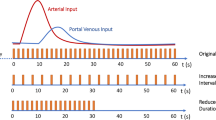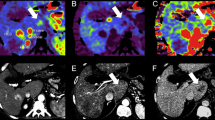Abstract
To investigate the clinical significance of 128 slice whole liver four dimensional computed tomography (4D CT) in diagnosis and differential diagnosis of hepatic disease, by characterizing and comparing perfusion maps in two common hepatic tumors: hepatocellular carcinoma (HCC) and liver hemangioma. 45 patients with HCC and 40 patients with liver hemangioma were subjected to 128 slice 4D CT of the whole liver perfusion scan, perfusion images were obtained, and data were processed by the perfusion software. Four perfusion parameters generated automatically were used to characterize and compare the perfusion of tumor tissue and surrounding hepatic parenchyma: blood flow perfusion (BF), arterial liver perfusion (ALP), portal venous perfusion (PVP), and hepatic perfusion index (HPI). Volumetric CT perfusion data then reconstructed to yield 4D CT angiography. Morphological observation was made regarding to the blood supply of tumor, intrahepatic vasculature. (1) In both HCC and hepatic hemangioma, BF, ALP, HPI were higher (P < 0.01), whereas PVP were lower (P < 0.01) in tumor tissue than the surrounding hepatic parenchyma (within 1 cm of lesion). Compared with liver hemangioma tumor tissue, BF, ALP, PVP were lower in HCC tumor tissue (P < 0.05; 0.01; 0.01), but HPI is higher (P < 0.05). For the perfusion of the surrounding parenchyma, BF and ALP were higher (P < 0.001), PVP was lower (P < 0.001) in HCC, while HPI was unchanged. (2) Among 45 cases with HCC, cancer feeding artery was found in 28 cases. In 20 cases feeding artery was shown as thickening, rigid, or distorted. Tumor thrombus in portal vein was found in 14 cases. For total of 40 cases with liver hemangioma, in 23 cases blood vessels are shifted due to compression from tumor mass, the rest 17 cases show normal vasculature. With application of 128 slice 4D CT, whole liver perfusion scan can reliably reflect the hemodynamic characteristics of HCC and hepatic hemangioma, proving to be a valuable adjunct to conventional imaging techniques of liver for early detection, differential diagnosis, and determining surgical resection range as well as estimating prognosis for hepatic tumors.


Similar content being viewed by others
References
Miles, K. A., Leggett, D. A., Kelley, B. B., Hayball, M. P., Sinnatamby, R., & Bunce, I. (1998). In vivo assessment of neovascularization of liver metastases using perfusion CT. The British Journal of Radiology, 71(843), 276–281.
Finn, R. S., & Zhu, A. X. (2009). Targeting angiogenesis in hepatocellular carcinoma: focus on VEGF and bevacizumab. Expert Review of Anticancer Therapy, 9(4), 503–509.
Sahani, D. V., Holalkere, N., Mueller, P. R., & Zhu, A. X. (2007). Advanced hepatocellular carcinoma: CT perfusion of liver and tumor tissue–initial experience. Radiology, 243(3), 736–743.
Goh, V., Halligan, S., Wellsted, D. M., & Bartram, C. I. (2009). Can perfusion CT assessment of primary colorectal adenocarcinoma blood flow at staging predict for subsequent metastatic disease? A pilot study. European Radiology, 19(1), 79–89.
Frampas, E., Lassau, N., Zappa, M., Vullierme, M., Koscielny, S., & Vilgrain, V. (2013). Advanced hepatocellular carcinoma: Early evaluation of response to targeted therapy and prognostic value of perfusion CT and dynamic contrast enhanced-ultrasound. Preliminary results. European Journal of Radiology, 82(5), e205.
Platt, J. F., Francis, I. R., Ellis, J. H., & Reige, K. A. (1997). Liver metastases: Early detection based on abnormal contrast material enhancement at dual-phase helical CT. Radiology, 205(1), 49–53.
Swensen, S. J. (1996). Lung nodule enhancement at CT: Prospective findings. Polish Journal of Radiology, 201(2), 447–455.
Park, Y. N., Yang, C. P., Fernandez, G. J., Cubukcu, O., Thung, S. N., & Theise, N. D. (1998). Neoangiogenesis and sinusoidal “capillarization” in dysplastic nodules of the liver. The American Journal of Surgical Pathology, 22(6), 656–662.
Ippolito, D., Capraro, C., Casiraghi, A., Cestari, C., & Sironi, S. (2012). Quantitative assessment of tumour associated neovascularisation in patients with liver cirrhosis and hepatocellular carcinoma: Role of dynamic-CT perfusion imaging. European Radiology, 22(4), 803–811.
Reiner, C. S., Goetti, R., Burger, I. A., Fischer, M. A., Frauenfelder, T., Knuth, A., et al. (2012). Liver perfusion imaging in patients with primary and metastatic liver malignancy: Prospective comparison between 99mTc-MAA spect and dynamic CT perfusion. Academic Radiology, 19(5), 613.
Yang, H. F., Du, Y., Ni, J. X., Zhou, X. P., Li, J. D., Zhang, Q., et al. (2010). Perfusion computed tomography evaluation of angiogenesis in liver cancer. European Radiology, 20(6), 1424–1430.
Xue, M., Bai, R., Li, F., et al. (2008). Differential value of CT perfusion imaging in heptocellular carcinoma, hepatic metastastas and hemangioma. International Journal of Radiology, 31(3), 152–155.
Li, M., Li, M., Gu, H., et al. (2012). Clinical application of MSCT in differential diagnosis of hepatic tumor. Journal of Clinical Radiology, 31(3), 369–373.
Barbara, L., Benzi, G., Gaiani, S., Fusconi, F., Zironi, G., Siringo, S., et al. (1992). Natural history of small untreated hepatocellular carcinoma in cirrhosis: A multivariate analysis of prognostic factors of tumor growth rate and patient survival. Hepatology (Baltimore, Md.), 16(1), 132–137.
Mazzaferro, V., Regalia, E., Doci, R., Andreola, S., Pulvirenti, A., Bozzetti, F., et al. (1996). Liver transplantation for the treatment of small hepatocellular carcinomas in patients with cirrhosis. The New England Journal of Medicine, 334(11), 693–700.
Monzawa, S., Ichikawa, T., Nakajima, H., Kitanaka, Y., Omata, K., & Araki, T. (2007). Dynamic CT for detecting small hepatocellular carcinoma: Usefulness of delayed phase imaging. AJR. American Journal of Roentgenology, 188(1), 147–153.
Fischer, M. A., Leidner, B., Kartalis, N., Svensson, A., Aspelin, P., Albiin, N., et al. (2014). Time-resolved computed tomography of the liver: Retrospective, multi-phase image reconstruction derived from volumetric perfusion imaging. European Radiology, 24(1), 151–161. doi:10.1007/s00330-013-2992-x.
Guiney, M. J., Kruskal, J. B., Sosna, J., et al. (2003). Multi-detector row CT of relevant vascular anatomy of the surgical plane in split-liver transplantation. Radiology, 229, 401–407.
Sahani, D., Saini, S., Pena, C., et al. (2002). Using multidetector CT for preoperative vascular evaluation of liver neoplasms: Technique and results. AJR, 179, 53–59.
Byun, J. H., Kim, T. K., Lee, S. S., et al. (2003). Evaluation of the hepatic artery in potential donors for living donor liver transplantation by computed tomography angiography using multidetector row computed tomography: Comparison of volume rendering and maximum intensity projection techniques. Journal of Computer Assisted Tomography, 27, 125–131.
Sone, M., Kato, K., Hirose, A., Nakasato, T., Tomabechi, M., et al. (2008). Impact of multislice CT angiography on planning of radiological catheter placement for hepatic arterial infusion chemotherapy. Cardiovascular and Interventional Radiology, 31(1), 91–97.
Author information
Authors and Affiliations
Corresponding author
Rights and permissions
About this article
Cite this article
Guo, M., Yu, Y. Application of 128 Slice 4D CT Whole Liver Perfusion Imaging in Hepatic Tumor. Cell Biochem Biophys 70, 173–178 (2014). https://doi.org/10.1007/s12013-014-9877-8
Published:
Issue Date:
DOI: https://doi.org/10.1007/s12013-014-9877-8




